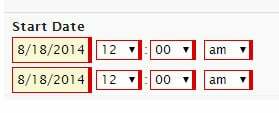I have a custom field renderer on a datetime field with a snippet that looks like this:
var field = arguments[0], value = skuid.utils.decodeHTML(arguments[1]),
$ = skuid.$;
var model = skuid.$M('TempAdder');
if(value == null){
value = skuid.time.getSFDate(new Date());
value += 'T04:00:00';
model.updateRow(model.getFirstRow(),'End\_Date\_\_c',value);
console.log(value);
}
skuid.ui.fieldRenderers[field.metadata.displaytype][field.mode](field,value);
I believe this was working fine before the new release but I might be wrong… Here is how my page looks now:

Any ideas?


